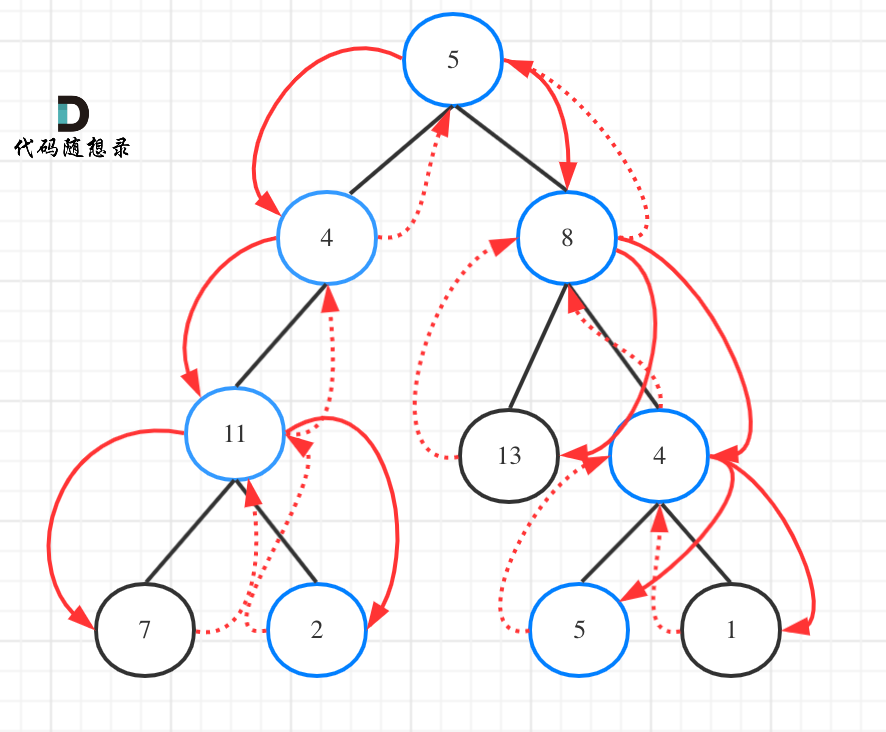代码随想录18 513.找树左下角的值 | 112. 路径总和 113.路径总和ii | 106.从中序与后序遍历序列构造二叉树 105.从前序与中序遍历序列构造二叉树
513. 找树左下角的值
给定一个二叉树的 根节点 root,请找出该二叉树的 最底层 最左边 节点的值。
假设二叉树中至少有一个节点。
示例 1:

输入: root = [2,1,3] 输出: 1
/** * Definition for a binary tree node. * public class TreeNode { * int val; * TreeNode left; * TreeNode right; * TreeNode() {} * TreeNode(int val) { this.val = val; } * TreeNode(int val, TreeNode left, TreeNode right) { * this.val = val; * this.left = left; * this.right = right; * } * } */ class Solution { int max = Integer.MIN_VALUE; int result = 0; private void helper(TreeNode root, int depth) { if (root.left == null && root.right == null) { if (depth > max) { max = depth; result = root.val; } return; } if (root.left != null) { depth++; helper(root.left, depth); depth--; } if (root.right != null) { depth++; helper(root.right, depth); depth--; } } public int findBottomLeftValue(TreeNode root) { helper(root, 0); return result; } }
112. 路径总和
给你二叉树的根节点 root 和一个表示目标和的整数 targetSum 。判断该树中是否存在 根节点到叶子节点 的路径,这条路径上所有节点值相加等于目标和 targetSum 。如果存在,返回 true ;否则,返回 false 。
叶子节点 是指没有子节点的节点。
/**
* Definition for a binary tree node.
* public class TreeNode {
* int val;
* TreeNode left;
* TreeNode right;
* TreeNode() {}
* TreeNode(int val) { this.val = val; }
* TreeNode(int val, TreeNode left, TreeNode right) {
* this.val = val;
* this.left = left;
* this.right = right;
* }
* }
*/
class Solution {
public boolean hasPathSum(TreeNode root, int targetSum) {
if (root == null) return false;
targetSum -= root.val;
if (root.left == null && root.right == null) {
return targetSum == 0;
}
if (root.left != null) {
boolean left = hasPathSum(root.left, targetSum);
if (left) {
return true;
}
}
if (root.right != null) {
boolean right = hasPathSum(root.right, targetSum);
if (right) {
return true;
}
}
return false;
}
}
113. 路径总和ii
给定一个二叉树和一个目标和,找到所有从根节点到叶子节点路径总和等于给定目标和的路径。
说明: 叶子节点是指没有子节点的节点。
示例: 给定如下二叉树,以及目标和 sum = 22,
/** * Definition for a binary tree node. * public class TreeNode { * int val; * TreeNode left; * TreeNode right; * TreeNode() {} * TreeNode(int val) { this.val = val; } * TreeNode(int val, TreeNode left, TreeNode right) { * this.val = val; * this.left = left; * this.right = right; * } * } */ class Solution { public List<List<Integer>> pathSum(TreeNode root, int targetSum) { List<List<Integer>> res = new ArrayList<>(); if (root == null) return res; // 非空判断 List<Integer> path = new LinkedList<>(); preorderdfs(root, targetSum, res, path); return res; } public void preorderdfs(TreeNode root, int targetsum, List<List<Integer>> res, List<Integer> path) { path.add(root.val); if (root.left == null && root.right == null) { // 找到了和为 targetsum 的路径 if (targetsum - root.val == 0) { res.add(new ArrayList<>(path)); } return; // 如果和不为 targetsum,返回 } if (root.left != null) { preorderdfs(root.left, targetsum - root.val, res, path); path.remove(path.size() - 1); } if (root.right != null) { preorderdfs(root.right, targetsum - root.val, res, path); path.remove(path.size() - 1); // 回溯 } } }
105
给定两个整数数组 inorder 和 postorder ,其中 inorder 是二叉树的中序遍历, postorder 是同一棵树的后序遍历,请你构造并返回这颗 二叉树 。
class Solution { Map<Integer, Integer> map; public TreeNode buildTree(int[] inorder, int[] postorder) { map = new HashMap<>(); for (int i = 0; i < inorder.length; i++) { map.put(inorder[i], i); } return findNode(inorder, 0, inorder.length, postorder,0, postorder.length); } private TreeNode findNode(int[] inorder, int inBegin, int inEnd, int[] postorder, int postBegin, int postEnd) { if (inBegin >= inEnd || postBegin >= postEnd) { // 不满足左闭右开,说明没有元素,返回空树 return null; } int rootIndex = map.get(postorder[postEnd - 1]); TreeNode root = new TreeNode(inorder[rootIndex]); // 构造结点 int lenOfLeft = rootIndex - inBegin; // 保存中序左子树个数,用来确定后序数列的个数 root.left = findNode(inorder, inBegin, rootIndex, postorder, postBegin, postBegin + lenOfLeft); root.right = findNode(inorder, rootIndex + 1, inEnd, postorder, postBegin + lenOfLeft, postEnd - 1); return root; } }


